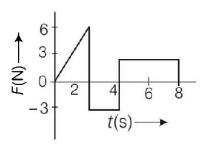Question
A ball of mass $$3\,kg$$ moving with a speed of $$100\,m/s,$$ strikes a wall at an angle $${60^ \circ }$$ (as shown in figure). The ball rebounds at the same speed and remains in contact with the wall for $$0.2\,s,$$ the force exerted by the ball on the wall is
A ball of mass $$3\,kg$$ moving with a speed of $$100\,m/s,$$ strikes a wall at an angle $${60^ \circ }$$ (as shown in figure). The ball rebounds at the same speed and remains in contact with the wall for $$0.2\,s,$$ the force exerted by the ball on the wall is

A.
$$1500\,\sqrt 3 N$$
B.
$$1500\,N$$
C.
$$300\,\sqrt 3 N$$
D.
$$300\,N$$
Answer :
$$1500\,\sqrt 3 N$$
Solution :
Apply 2nd law of motion i.e., rate of change of momentum is equal to force applied. The vector $$OA$$ represents the momentum of the wall, before the collision and the vector $$OB$$ that after the collision. The vector $$AB$$ represents the change in momentum of the ball $$\Delta P.$$
As, the magnitude of $$OA$$ and $$OB$$ are equal the components of $$OA$$ and $$OB$$ along the wall are equal and in the same direction, while those perpendicular to the wall are equal and opposite. Thus, the change in momentum is only due to the change in direction of the perpendicular components.

Hence, $$\Delta P = OA\sin {60^ \circ } - \left( { - OB\sin {{60}^ \circ }} \right)$$
$$\eqalign{ & = mv\sin {60^ \circ } + mv\sin {60^ \circ } \cr & = 2mv\sin {60^ \circ } \cr & = 2 \times 3 \times 100 \times \frac{{\sqrt 3 }}{2} \cr & = 300\sqrt 3 \,kg - m/s \cr} $$
The force exerted on the wall
$$F = \frac{{\Delta p}}{{\Delta t}} = \frac{{300\sqrt 3 }}{{0.2}} = 1500\sqrt 3 N$$
Apply 2nd law of motion i.e., rate of change of momentum is equal to force applied. The vector $$OA$$ represents the momentum of the wall, before the collision and the vector $$OB$$ that after the collision. The vector $$AB$$ represents the change in momentum of the ball $$\Delta P.$$
As, the magnitude of $$OA$$ and $$OB$$ are equal the components of $$OA$$ and $$OB$$ along the wall are equal and in the same direction, while those perpendicular to the wall are equal and opposite. Thus, the change in momentum is only due to the change in direction of the perpendicular components.

Hence, $$\Delta P = OA\sin {60^ \circ } - \left( { - OB\sin {{60}^ \circ }} \right)$$
$$\eqalign{ & = mv\sin {60^ \circ } + mv\sin {60^ \circ } \cr & = 2mv\sin {60^ \circ } \cr & = 2 \times 3 \times 100 \times \frac{{\sqrt 3 }}{2} \cr & = 300\sqrt 3 \,kg - m/s \cr} $$
The force exerted on the wall
$$F = \frac{{\Delta p}}{{\Delta t}} = \frac{{300\sqrt 3 }}{{0.2}} = 1500\sqrt 3 N$$


